In the realm of e-commerce, Amazon stands out as a leading platform for sellers to showcase and sell their products to a global audience. However, maintaining a healthy seller account on Amazon requires diligence, attention to detail, and a proactive approach. In this article, we will discuss 5+ essential tips to maintain your Amazon seller account and ensure its long-term success.
Table of Contents
Stay Compliant with Amazon’s Policies
To maintain your Amazon seller account, it is vital to stay compliant with Amazon’s policies and guidelines. Amazon has strict policies in place to ensure a fair and safe marketplace for both buyers and sellers. As a seller, it’s your responsibility to adhere to these policies to maintain a good standing with Amazon. Failure to comply with these policies can result in penalties, suspension, or even permanent removal of your selling privileges.
To avoid any issues, make sure to familiarize yourself with Amazon’s policies and guidelines. These include the Prohibited Seller Activities and Actions policy, Product Listing Policy, and Community Rules. It’s also important to keep up-to-date with any changes or updates to these policies.
Read more: Amazon Product Listing

Familiarize yourself with Amazon’s policies and guidelines to avoid complications
Check Your Account Health Rating
Another key factor to maintain your Amazon seller account is your Account Health Rating. Maintain Amazon seller account health rating is pivotal to understanding how Amazon perceives your performance as a seller.
Your account health rating is a reflection of various metrics, including customer feedback, order defect rates, and policy compliance. You can find your Account Health Rating under the Performance tab in your Seller Central account.
Aim to keep your rating high to establish trust with Amazon and potential buyers. A high Account Health Rating can also provide you with a competitive advantage.
Regularly check your account health dashboard to identify any areas that require improvement and take proactive measures to address them. Addressing any issues promptly can help prevent negative impacts on your account health and performance metrics.
Monitor Your Seller Metrics & Performance Notifications
Your Account Health Rating is determined by seven different metrics, each with its own target threshold. Let’s take a closer look at these metrics and how you can improve them to maintain a good Account Health Rating.

There are seven distinct metrics that contribute to the calculation of your Account Health Rating
Order Defect Rate (ODR)
The Order Defect Rate (ODR) measures the percentage of orders that have received negative feedback, A-to-z Guarantee claims, or credit card chargebacks. Amazon considers an ODR of 1% or lower as good, while anything above 1% can negatively impact your Account Health Rating.
To maintain a low ODR, make sure to provide accurate product descriptions, fulfill orders on time, and respond promptly to customer inquiries or issues. You should also monitor your feedback and ratings regularly and address any negative feedback immediately.
Cancellation Rate (CR)
The Cancellation Rate reflects the percentage of orders that are canceled by either the seller or the buyer. A high CR can indicate poor inventory management or inaccurate product listings. Amazon’s target threshold for CR is 2.5%, and anything above this can affect your Account Health Rating.
To reduce your CR, make sure to manage your inventory effectively and only list products that are in stock. You should also keep your product listings up-to-date and accurate to avoid any cancellations due to incorrect information.
Late Dispatch Rate (LDR)
Timely order fulfillment is essential for customer satisfaction. The Late Dispatch Rate measures the percentage of orders that were not shipped within the expected handling time. Amazon expects sellers to ship orders within one business day, and a high LDR can result in a poor Account Health Rating.
To avoid a high LDR, make sure to fulfill orders promptly and communicate with buyers if there are any delays. You should also set realistic handling times for your products and update them as needed.
Valid Tracking Rate (VTR)
Providing valid tracking information for orders is essential for ensuring a positive customer experience. The Valid Tracking Rate measures the percentage of orders that have valid tracking numbers. This metric is important for Amazon to track the delivery of orders and ensure a positive customer experience. The target threshold for VTR is 95%, and anything below this can negatively impact your Account Health Rating.
To improve your VTR, make sure to use reliable shipping carriers and provide tracking numbers for all your orders. If you’re using Fulfillment by Amazon (FBA), Amazon will automatically provide tracking numbers for your orders.
On-Time Delivery Rate (OTDR)
The On-Time Delivery Rate reflects the percentage of orders that are delivered to customers within the promised timeframe. Amazon expects sellers to maintain a high OTDR to ensure a positive customer experience. The target threshold for OTDR is 97%, and anything below this can affect your Account Health Rating.
To improve your OTDR, make sure to fulfill orders promptly and use reliable shipping carriers. You should also communicate with buyers if there are any delays in delivery.
Return Dissatisfaction Rate (RDR)
The Return Dissatisfaction Rate (RDR) measures the percentage of orders that have received negative feedback or A-to-z Guarantee claims due to returns. A high RDR can indicate poor product quality or inaccurate product listings. Amazon’s target threshold for RDR is 10%, and anything above this can negatively impact your Account Health Rating.
To reduce your RDR, make sure to provide accurate product descriptions and images, and manage your inventory effectively to avoid selling low-quality products. You should also handle returns promptly and address any issues or concerns from buyers.
Performance Notifications
In addition to these metrics, Amazon also considers your overall performance as a seller when determining your Account Health Rating. This includes your response time to customer inquiries, order defect rate, and other factors. It’s important to monitor your performance notifications regularly and take necessary actions to improve your performance.
Provide Excellent Customer Service
Providing excellent customer service is crucial to maintain your Amazon seller account health. Amazon values customer satisfaction and expects sellers to prioritize their customers’ needs and concerns. By providing exceptional customer service, you can build trust with your customers and increase the chances of receiving positive feedback and ratings.
To provide excellent customer service, make sure to respond promptly to customer inquiries and address any issues or concerns they may have. You should also be transparent and honest with your customers and provide accurate information about your products and services.
Optimize Your Product Listings
Optimizing your product listings is essential for enhancing visibility and driving sales on Amazon. A well-optimized listing can also improve your search ranking and visibility on the platform. To optimize your product listings, make sure to:
- Use high-quality images that accurately represent your products.
- Write clear and concise product titles and descriptions.
- Incorporate appropriate keywords into your titles and descriptions to improve searchability.
- Provide accurate information about your products, including size, color, and other variations.
- Monitor and respond to customer reviews and feedback to improve your product listings.

Instructions for step-by-step optimization of your product listings
Manage Your Inventory and Fulfill Orders on Time
Effective inventory management is essential to maintain your Amazon seller account. You should always have enough stock of your products to fulfill orders promptly and avoid any cancellations or delays. It’s also important to monitor your inventory levels and update them regularly to avoid overselling.
If you’re using Fulfillment by Amazon (FBA), Amazon will handle the fulfillment process for you. However, it’s still important to monitor your inventory levels and communicate with Amazon if there are any issues or concerns.
To maintain your Amazon seller account, one must adopt a multifaceted approach. By implementing the tips outlined in this guide, sellers can position themselves for sustained success on the platform. Regularly review and update your strategies to adapt to the evolving landscape of e-commerce and ensure your continued growth as an Amazon seller.











